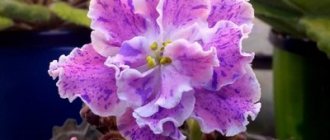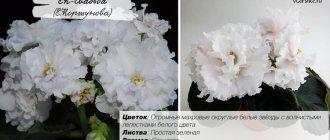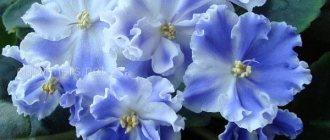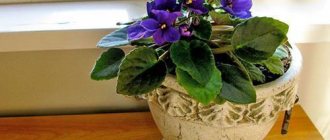The indoor violet has rightfully conquered many window sills, greenhouses and greenhouses . This small flower captivates with its compactness, aesthetics and beautiful flowering.
But still, most people mistakenly call them violets, because they have almost nothing in common with the plants that bear this name. The official name is Saintpaulia , in some sources they are still called Uzambara violets.
So what family do violets belong to? What is the difference from Saintpaulias and how to distinguish them?
To eliminate mistakes, we will below provide a brief description of violets: interesting facts, history of origin and superstitions about these indoor plants, photos of various varieties.
All about violets
Natural habitat
The ancestors of modern indoor pets grow in Africa. The massifs of the Ulugur and Usambara (Usambara) mountains are the natural habitat of Saintpaulia , most varieties are located on the slopes of the latter and therefore received a second name, Usambara (Usambara) violet.
Violets in natural conditions.
In East Africa, violets grow in humid climates, often near waterfalls and on river terraces. In such conditions there is a lot of water dust and fog, and the soil is light and well permeable to moisture and air.
Origin story
The description of indoor plants should begin with the history of their occurrence in nature.
Walter von Saint-Paul , Commandant of the Uzambara District of German East Africa – German Colony. In 1892, while studying the flora and fauna of the territories subordinate to him, he discovered flowers in the mountains and collected seeds to understand what kind of plant it was.
They were then sent to his father, who was the president of the German Dendrological Society, Ulrich von Saint-Paul, and this is how they ended up with Hermann Wendland.
The scientist named the cultivated plant grown in 1893 Saintpaulia , and the name was given to the addition violet flower for the shape of the flower. This species was separated into a separate genus, named after the father and son who discovered it.
Next, the flower was presented at an exhibition in Goethe, where the rights to breed on a production scale were purchased by the Benari company.
Violets were brought to the USA in 1927 , and there they were recognized as ideal indoor plants. From that moment on, the mass production of new varieties began and by 1949 there were already 100 of them, and today their number is more than 32 thousand.
Important! More than 2000 varieties have been bred by domestic breeders.
Biological classification
So, what is a violet from a biological point of view - is it an herbaceous plant or not? Saintpaulias are classified as a separate genus - they are evergreen herbaceous plants of the Gesneriaceae family.
The structure of an indoor violet is as follows:
- the stem is shortened, which leads to the formation of a rosette of leaves;
- the leaves are respectively arranged in rows and very close to each other;
- the leaves on the stem are round in shape, fleshy and leathery, covered with villi;
- the base of the leaves is usually slightly heart-shaped, and the apex is rounded or slightly pointed;
- The color of the leaves varies from dark to light green; they are also variegated and spotted, sometimes almost white.
Next, is the violet a monocot or a dicotyledon? The houseplant violet is bipolar . Flowers collected in racemes usually have five petals, several stamens and one pistil. The calyx consists of five sepals located on the receptacle. The violet flower pattern is shown in the picture below.
The structure of a violet flower.
After pollination, a seed capsule is formed. The seeds themselves are very small and have average germination capacity, which is lost over time.
Based on this information, you can create a passport for a houseplant:
- plant biology passport: Kingdom: plants;
- Department: flowering;
- Class: double-field;
- Order: clear-flowered;
- Family: Gesneriaceae;
- Genus: Saintpaulia;
- Application: indoor plants;
- Natural area: mountainous areas of eastern Africa.
- simplified violet plant passport for kindergarten: Kingdom: plants;
- Department: flowering;
- Genus: Saintpaulia;
- Use: indoor plants.
Caring for Saintpaulia at home
Almost all varieties of Saintpaulia require the same conditions, with the exception of fantasy violets and chimeras.
Planting and growing them is quite difficult.
| Factor | Growing season | Winter |
| Location/lighting | West or east window. For a more uniform distribution of light, the flower is constantly rotated and additional lighting is used. Cold drafts and direct sunlight are unacceptable. | |
| Temperature | +20…+22 °C, no differences allowed. | Not lower than +15 °C. |
| Humidity | Not less than 50%. For maintenance, spray with a fine spray, place in a tray with damp pebbles, or place with other flowers. | 50 %. |
| Watering | After the soil on top dries, it should be moist, but without stagnant water. | They limit. |
| Use filtered water at room temperature, being careful not to get on the leaves. | ||
| Top dressing | Once every 2 weeks with complex mineral fertilizers. | Not used. |
| The soil | Soil for Saintpaulias or composition: leaf, turf, coniferous and peat soil (3: 2: 1: 1), add vermiculite, perlite, coarse river sand and chopped moss (1). | |
| Pot | Take 3 times less violets, since the roots of the plant are small and do not need a lot of soil. | |
| Transfer | As a rule, they are produced once every 3 years. The flower has a sensitive root system, so it is often not recommended to disturb it. | |
Stimulation of flowering
If the care is not good enough, the violet will not bloom; this happens in the following cases:
- low lighting;
- lack of nutrition; improper watering;
- dense soil;
- large pot;
- infection by diseases or pests.
To stimulate the plant, it is necessary to eliminate all errors: transplant it into a smaller container, change the substrate, feed it, treat it with a fungicide and insecticide.
Energy influence and superstitions
A description of indoor violets will be incomplete without mentioning their energy component. Violets are very sensitive not only to drafts from the window, but also to bad energy in the house.
In homes where there is a lot of arguing and family members suffer from mood swings and depression, violets usually bloom poorly and tend to disappear.
Attention! The zodiac sign that violet corresponds to is Taurus. Like this sign, Saintpaulias symbolize harmony, stability and tranquility.
Violet brings peace and harmony to the house, cleanses the space of negativity . By bringing wealth into the home, it improves health and extends life expectancy.
The energy of plants depends partly on their color:
- white - purity, femininity, peace, tranquility, liberation from oppression.
This color is suitable for calming, both for people in a state of aggression and for those who are emotionally very sensitive. Dulling the feeling of anger, worries and fears, communication with a white violet brings peace. It is recommended to place white violets in rooms where children live, especially if quarrels often arise between them; - red of all shades - cleanse the house of negative energy, treat depression, and help pessimists. A person who has a violet of these colors in his house begins to have a more positive attitude towards his life;
- blue and blue - personify the unification of the earthly and airy, awakens creative abilities. They are often placed in the rooms of children who are trying to teach art - music, singing, drawing. Blue color also reduces appetite, and it is useful to place them in the kitchen if you want to lose weight;
- purple - helps mutual understanding, comprehension of the spiritual, wise, as well as for meditation and reading the future. They are hosted by teachers, writers, psychologists, philosophers and thinkers.
What does it look like
The buds of tricolor violets (pansies) are much smaller than those of their decorative counterpart. The flower is classified as a two- or three-year-old plant with a height of 10 to 45 cm. The stem is straight. The upper leaves are elliptical and the lower leaves are ovate.
Tricolor violet flowers are beautiful and always come in 3 shades. The upper petals most often acquire a lilac or blue palette. Below - much lighter, snow-white or yellowish.
Classification and varieties
In folk medicine, 3 varieties of flowers are used, the characteristics and botanical descriptions of which have a number of differences:
- Tricolor. Features larger flowers. Petals 3 shades. The predominant color is dark blue or purple. The stem grows up to 45 cm.
- Field. Buds of 2 colors. The upper petals are often white, sometimes light purple. The lower ones are bright and golden. Stems are from 15 to 35 cm tall. The flowers are smaller. It produces buds later than the tricolor variety - from mid-May to September. The medicinal herb contains more alkaloids and less saponins.
- Doubtful or changeable. It is distinguished by fragrant inflorescences. It is a poisonous herb, but is widely used as a remedy. Based on it, decoctions are prepared and used externally. It has proven itself excellent in the treatment of inflammatory processes of the epidermis, swelling and wounds.
Application
In violet tricolor, the herb is used as an expectorant. It enhances the secretion of the bronchi and promotes the rapid separation of sputum. In addition, a decoction of the flower allows you to stop inflammatory processes and relieve pain.
The use of the flower in cosmetology has proven itself to be excellent. Violet compresses help eliminate acne and remove oily shine on the skin. Lubricating foci of inflammation normalizes the functioning of the sebaceous glands and eliminates itching.
Life cycles
When buying a little baby, you always wonder how long such flowers grow. Violets grow quite quickly, from a small baby to an adult blooming violet in just six months to a year, depending on the variety.
It takes no more than a year from cutting to adult plant.
Violets are propagated by leaves, shoots and peduncles. Children from stepchildren bloom the fastest, and later than all from peduncles.
The stages of violet growth can be divided:
- A cutting from a leaf or peduncle (leaves are taken from the second or third row and rooted in a convenient way);
- A baby from a cutting or a stepson (children are separated from the cuttings when they reach a height that allows them to exist independently; stepchildren are separated from the mother at approximately the same size, preferably with several roots);
- Starter or teenager (a violet that is ready to bloom, and often is already blooming, but has not yet reached its adult height);
- Adult.
Shoots or stepsons are formed in the axils of the leaves. They grow quite quickly and when they reach the size of a large baby, they are removed.
Important! Knowing how violets grow in nature, growing them at home will not cause much difficulty.
Features of Saintpaulia, its appearance
You already know that the birthplace of violets is Africa. Saintpaulia is a perennial plant up to 30 cm high. It has a short stem, large leaves, and an oval shape. Some types of violets have heart-shaped or elongated leaves. The color also differs - from light to dark green.
Visual photos confirm the incredible variety of colors and shapes. You can find a flower with double, corrugated, wavy or fringed petals. The average diameter is 2-4 cm, both single-color and multi-color colors are found. Night violet and Labrador violet, swamp violet and butterfly violet... It seems as if all these varieties are competing with each other in beauty.
Previously, indoor Saintpaulia had no smell and pleased gardeners solely with its appearance. As a result of long and painstaking breeding work, hybrids with a subtle, very pleasant aroma were bred.
Features of the plant and interesting facts about violet
Violets are very delicate, fragile and at the same time they are resistant to various irritants and changes in conditions. Saintpaulias tolerate shortcomings of care well if they are not neglected critically.
Interestingly, there are two legends about the appearance of violets on the slopes of the African mountains:
- the first legend talks about Adam's tears, which turned into Saintpaulia flowers;
- the second version is Greek - Zeus, the supreme god of Olympus, turned a nymph running away from Apollo and asking for protection into this flower.
They also believe that violets should not be placed in the house of unmarried women , because they drive men away from the house. But this sign accompanies many colors, most often without reason.










